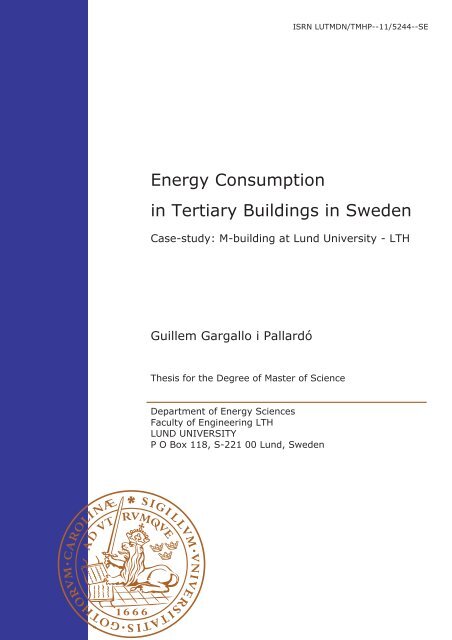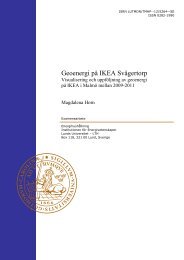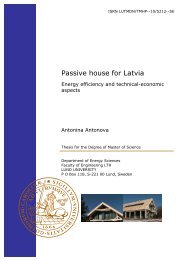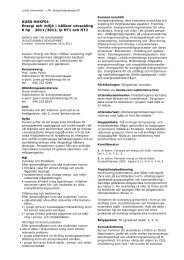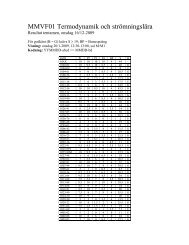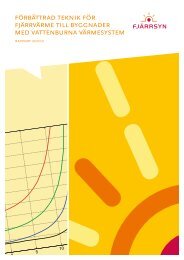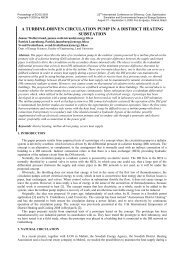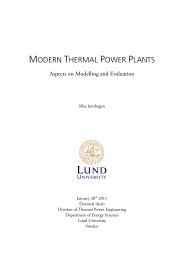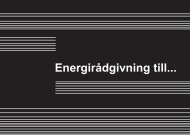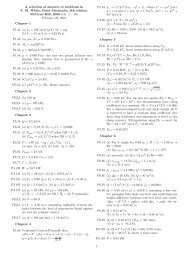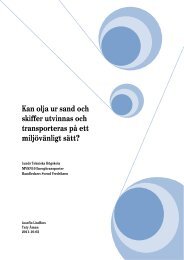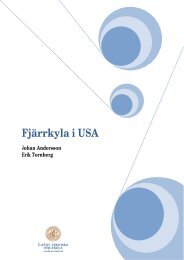Energy Consumption in Tertiary Buildings in Sweden - Case-study
Energy Consumption in Tertiary Buildings in Sweden - Case-study
Energy Consumption in Tertiary Buildings in Sweden - Case-study
You also want an ePaper? Increase the reach of your titles
YUMPU automatically turns print PDFs into web optimized ePapers that Google loves.
ISRN LUTMDN/TMHP--11/5244--SE<br />
<strong>Energy</strong> <strong>Consumption</strong><br />
<strong>in</strong> <strong>Tertiary</strong> Build<strong>in</strong>gs <strong>in</strong> <strong>Sweden</strong><br />
<strong>Case</strong>-<strong>study</strong>: M-build<strong>in</strong>g at Lund University - LTH<br />
Guillem Gargallo i Pallardó<br />
Thesis for the Degree of Master of Science<br />
Department of <strong>Energy</strong> Sciences<br />
Faculty of Eng<strong>in</strong>eer<strong>in</strong>g LTH<br />
LUND UNIVERSITY<br />
P O Box 118, S-221 00 Lund, <strong>Sweden</strong>
<strong>Energy</strong> <strong>Consumption</strong> <strong>in</strong> <strong>Tertiary</strong><br />
Build<strong>in</strong>gs <strong>in</strong> <strong>Sweden</strong><br />
<strong>Case</strong>-<strong>study</strong>: M-build<strong>in</strong>g at Lund University - LTH<br />
Guillem Gargallo i Pallardó<br />
Supervised by Jurek Pyrko<br />
Thesis for the Degree of Master of Science 2011<br />
Efficient <strong>Energy</strong> Systems<br />
Department of <strong>Energy</strong> Sciences<br />
Lund University - LTH<br />
www.ees.energy.lth.se
Thesis for the Degree of Master of Science<br />
ISRN LUTMDN/TMHP--11/5244--SE<br />
© 2011 Guillem Gargallo i Pallardó<br />
and <strong>Energy</strong> Sciences<br />
Efficient <strong>Energy</strong> Systems<br />
Department of <strong>Energy</strong> Sciences<br />
Lund University - LTH<br />
Box 118, 221 00 Lund, <strong>Sweden</strong><br />
www.ees.energy.lth.se
Abstract: <strong>Energy</strong> consumption rema<strong>in</strong>s <strong>in</strong>visible for most of consumers. This problem is even <br />
worse <strong>in</strong> the tertiary sector where <strong>in</strong> most cases the direct consumer doesn’t even pay the <br />
bill. Therefore it’s important to know how energy is used to be able to decide where and <br />
how energy efficiency measures should be applied <strong>in</strong> order to improve the effectiveness of <br />
those actions. This report is focused on one specific university build<strong>in</strong>g <strong>in</strong> Lund, <strong>Sweden</strong>, M-build<strong>in</strong>g<br />
at the LTH campus area. <br />
The ma<strong>in</strong> goal of this <strong>in</strong>vestigation was to <strong>study</strong> the field of energy behaviour <strong>in</strong> <br />
service sector. In order to achieve it, the research was divided <strong>in</strong>to three ma<strong>in</strong> parts: <br />
The first goal of the project was to create an energy profile of the consumer as well as <strong>study</strong> <br />
the f<strong>in</strong>al energy use <strong>in</strong> order to decide where and how energy sav<strong>in</strong>g measures should be <br />
implemented to be more effective. <br />
Secondly, it was important to evaluate the potential of energy sav<strong>in</strong>gs due to user habits at <br />
M-‐buil<strong>in</strong>g at Lund University – LTH. <br />
F<strong>in</strong>ally, the last objective was to apply different measures to achieve energy sav<strong>in</strong>gs by a <br />
change <strong>in</strong> behaviour and <strong>study</strong> the effectiveness of those measures. get a general picture of <br />
the employees’ use of energy, to create an energy profile of users’ behaviour, and to <br />
propose some energy sav<strong>in</strong>gs measures. <br />
The <strong>study</strong> was done by carry<strong>in</strong>g out two surveys: one about electrical appliances <strong>in</strong> the <br />
offices and another one about the employees’ energy behaviour. 99 and 75 respondents <br />
answered the surveys respectively. One of the results was that the ma<strong>in</strong> loads at the offices <br />
were computers and screens with a 71.1% of the total. Even if the general energy related <br />
behaviour was correct, accord<strong>in</strong>g to the standard used, there were still some potential <br />
sav<strong>in</strong>gs through a change <strong>in</strong> daily habits such as computers use. However, to quantify exactly <br />
the potential sav<strong>in</strong>gs a more accurate measurement system would be needed s<strong>in</strong>ce the M-build<strong>in</strong>g<br />
only had one electric meter and the load demand is ma<strong>in</strong>ly affected by operational <br />
loads. <br />
i
Acknowledgements<br />
Thanks to Jurek Pyrko, my supervisor, for his guidance, k<strong>in</strong>d help and for<br />
offer<strong>in</strong>g me the possibility to carry out this project. I have learned many th<strong>in</strong>gs from<br />
him. Thanks to Hans Petersson, from Akademiska Hus, he was really helpful and<br />
without his patience this project couldn’t have been done.<br />
Guillem Gargallo i Pallardó, Lund, December 2011.<br />
ii
TABLE OF CONTENTS<br />
INTRODUCTION ................................................................................................................ 1<br />
Background ................................................................................................................... 1<br />
Objectives ..................................................................................................................... 2<br />
Methodology ................................................................................................................. 3<br />
<strong>Energy</strong> profile and appliances use ............................................................................ 3<br />
Evaluation of potential energy sav<strong>in</strong>gs ..................................................................... 3<br />
Limitations ...………………………………………………………………………………………………………….4<br />
LITERATURE SURVEY ......................................................................................................... 5<br />
<strong>Tertiary</strong> build<strong>in</strong>gs <strong>in</strong> <strong>Sweden</strong>......................................................................................... 5<br />
<strong>Energy</strong> behaviour .......................................................................................................... 9<br />
CASE-STUDY: M-build<strong>in</strong>g at Lund University - LTH ......................................................... 10<br />
Akademiska Hus .......................................................................................................... 10<br />
M-build<strong>in</strong>g ............................................................................................................... 11<br />
RESULTS .......................................................................................................................... 13<br />
Electrical appliances use ............................................................................................. 13<br />
<strong>Energy</strong> profile ............................................................................................................. 15<br />
Evaluation of potential sav<strong>in</strong>gs ................................................................................... 18<br />
Measures taken .......................................................................................................... 20<br />
CONCLUSSION AND DISCUSSION ................................................................................... 21<br />
Future research ........................................................................................................... 22<br />
REFERENCES .................................................................................................................... 23<br />
Recommended literature............................................................................................25<br />
APPENDICES .................................................................................................................... 27<br />
APPENDIX 1 ................................................................................................................. 27<br />
APPENDIX 2 ................................................................................................................. 32<br />
iii
INTRODUCTION<br />
Background<br />
The energy supplyed <strong>in</strong> <strong>Sweden</strong> was of 568 TWh <strong>in</strong> 2009. This corresponds with<br />
an average value of about 63.7 MWh per capita. The total f<strong>in</strong>al use was 376 TWh<br />
accord<strong>in</strong>g to the Swedish <strong>Energy</strong> Agency (S.E.A.) and 367 TWh accord<strong>in</strong>g to Eurostat<br />
(2011). That means losses of 192 TWh and 201 TWh respectively for non-energy<br />
purposes such as conversion losses or <strong>in</strong>ternational transport.<br />
183 13 18 127 5,5 66 149<br />
2,5<br />
4,7<br />
Crude oil and oil products Natural gas Coal-Coke<br />
Biofuels, peat, waste… Heat pumps Hydro power<br />
Nuclear power W<strong>in</strong>d power Import/Export<br />
Figure 1: Total energy supplied <strong>in</strong> <strong>Sweden</strong> 2009 per energy carrier. Source S.E.A. 2010<br />
The distribution of energy consumption per sector <strong>in</strong> 2009 is shown <strong>in</strong> Figure 2.<br />
Compared with the EU-27 average, <strong>Sweden</strong> has a higher percentage of energy<br />
consumption <strong>in</strong> the <strong>in</strong>dustry and services sectors, while it has a lower ratio <strong>in</strong> transport<br />
and residential sector. It’s remarkable that, compared to the EU-27 average, the<br />
percentage of energy used <strong>in</strong> Industrial sector is 11 po<strong>in</strong>ts higher only surpassed by<br />
F<strong>in</strong>land.<br />
35,30% 27,01% 21,99% 13,40% 2,19%<br />
0,00% 10,00% 20,00% 30,00% 40,00% 50,00% 60,00% 70,00% 80,00% 90,00% 100,00%<br />
Industry Transport Residential Services Others<br />
Figure 2: F<strong>in</strong>al energy use per sector. Source: Eurostat 2011<br />
1
With more than 14000 kWh per-capita of electricity consumption, <strong>Sweden</strong> is<br />
one of the countries with highest electricity consumption <strong>in</strong> the world. Only Iceland,<br />
Norway, Canada and F<strong>in</strong>land have a higher ratio. Compar<strong>in</strong>g to EU-27 average, <strong>Sweden</strong><br />
uses more than the double of electricity per capita. This is undoubtedly due to the cold<br />
climate. However, other factors such as historically low electricity prices and a high<br />
proportion of electricity-<strong>in</strong>tensive <strong>in</strong>dustries contribute to this fact (S.E.A. 2010).<br />
Service sector represents, with 43.23 TWh, the 13.4% of the Swedish energy<br />
consumption. This is almost as much as the total energy consumption of a country like<br />
Latvia. Therefore it’s important to <strong>study</strong> this sector to get a general overview on how<br />
energy is used <strong>in</strong> order to apply the most effective sav<strong>in</strong>g measures.<br />
Objectives<br />
The aim of this report was to <strong>study</strong> the fieldofenergybehaviour<strong>in</strong>servicesector.<br />
In order to achieve it, the research was divided <strong>in</strong>to three ma<strong>in</strong> parts:<br />
The first goal of the project was to create an energy profile of the consumer as<br />
well as <strong>study</strong> the f<strong>in</strong>al energy use <strong>in</strong> order to decide where and how energy sav<strong>in</strong>g<br />
measures should be implemented to be more effective.<br />
Secondly, it was important to evaluate the potential of energy sav<strong>in</strong>gs due to<br />
user habits at M-buil<strong>in</strong>g at Lund University – LTH.<br />
F<strong>in</strong>ally, the last objective was to apply different measures to achieve energy<br />
sav<strong>in</strong>gs by a change <strong>in</strong> behaviour and <strong>study</strong> the effectiveness of those measures.<br />
2
Methodology<br />
<strong>Energy</strong> profile and appliances use<br />
The first part of the project was the creation of the user energy profile and the<br />
<strong>study</strong> of the use of energy. This part was carried out through two surveys.<br />
The first survey (about energy user behaviour) was developed <strong>in</strong> a previous<br />
phase of this <strong>study</strong> (see Gargallo i Pallardó 2011). The survey consisted of different<br />
questions about daily habits on energy use such as deal<strong>in</strong>g with light<strong>in</strong>g, heat<strong>in</strong>g or<br />
computer use. Each response was scored accord<strong>in</strong>g to the criterion determ<strong>in</strong>ed <strong>in</strong> the<br />
previous phase. This criterion consisted basically on scor<strong>in</strong>g as zero the behaviour<br />
considered correct, mean<strong>in</strong>g by correct the behaviour that uses less energy without<br />
affect<strong>in</strong>g consumers’ comfort. Positive po<strong>in</strong>ts were given to better habits than the<br />
standard and negative po<strong>in</strong>ts were given for worse behaviour than the standard.<br />
This survey was distributed through an on-l<strong>in</strong>e application. The <strong>in</strong>tent to<br />
distribute it this way was to facilitate the process<strong>in</strong>g of results. S<strong>in</strong>ce the answers were<br />
anonymous the risk of receiv<strong>in</strong>g few answers was assumed. The fact of receive more or<br />
less answers would be considered as a result itself of the will<strong>in</strong>gness of the employees<br />
to participate on the program.<br />
The aim to get the energy profile was to figure out where and how more energy<br />
was wasted <strong>in</strong> order to focus the measures <strong>in</strong> the po<strong>in</strong>ts with most potential for<br />
sav<strong>in</strong>gs. A version of the survey with the score for each response can be found <strong>in</strong><br />
Appendix 1.<br />
The second survey was about electrical appliances use. The aim of this survey<br />
was to get an approximate view of how energy is used <strong>in</strong> the offices and therefore<br />
where it should be convenient to focus the measures. This survey was on paper form<br />
(see Appendix 2) to make easier to get the answers from the respondents. Once the<br />
facts were collected the follow<strong>in</strong>g step was to analyse the different loads and the<br />
weight of each appliance <strong>in</strong> the global load demand.<br />
Evaluation of potential energy sav<strong>in</strong>gs<br />
The second part was to <strong>study</strong> the potential of energy sav<strong>in</strong>gs. This part was<br />
done <strong>in</strong> collaboration with Akademiska Hus (AH – Academic Houses <strong>in</strong> English), the<br />
company that owns many university build<strong>in</strong>gs <strong>in</strong> <strong>Sweden</strong>.<br />
3
In order to determ<strong>in</strong>e the potential sav<strong>in</strong>gs data of energy load for the last two<br />
years were analysed. These data were provided by AH. They have meters with possible<br />
hourly meters so the feedback could be almost <strong>in</strong>stantaneous.<br />
Another measure to determ<strong>in</strong>e the potential sav<strong>in</strong>gs was to ask users to turn<br />
off all the non-essential appliances dur<strong>in</strong>g one night. The aim was to see the<br />
differences between the load curves of a normal day and the day of the test us<strong>in</strong>g the<br />
data provided by AH.<br />
For all the calculations concern<strong>in</strong>g areas BRA area was used. This means all the<br />
usable area (or “bruksarea” <strong>in</strong> Swedish). This is the measured area <strong>in</strong>side the external<br />
walls were non-heated areas (
LITERATURE SURVEY<br />
<strong>Tertiary</strong> build<strong>in</strong>gs <strong>in</strong> <strong>Sweden</strong><br />
The total f<strong>in</strong>al energy use <strong>in</strong> services sector <strong>in</strong> <strong>Sweden</strong> <strong>in</strong> 2009 was 49.23 TWh<br />
accord<strong>in</strong>g to Eurostat. Figure 3 shows the total f<strong>in</strong>al energy use per energy carrier for<br />
the residential and services sector. There it can be observed that electricity and district<br />
heat<strong>in</strong>g represent the ma<strong>in</strong> part of the f<strong>in</strong>al energy use <strong>in</strong> the residential and services<br />
sector. This is a characteristic distribution <strong>in</strong> a northern country were heat<strong>in</strong>g is ma<strong>in</strong>ly<br />
done by district heat<strong>in</strong>g <strong>in</strong>stead of <strong>in</strong>dividual heat<strong>in</strong>g systems like <strong>in</strong> southern<br />
European countries.<br />
1,28%<br />
8,72% 10,07% 48,99% 30,87%<br />
0,00% 20,00% 40,00% 60,00% 80,00% 100,00%<br />
Oil products Natural gas Biofuels, peat, etc. Electricity District heat<strong>in</strong>g<br />
Figure 3: F<strong>in</strong>al energy use per energy carrier <strong>in</strong> residential and services sector 2009. Source Swedish<br />
<strong>Energy</strong> Agency (S.E.A.)<br />
The use of heat<strong>in</strong>g and hot water <strong>in</strong> non-residential premises was of 17.7 TWh<br />
<strong>in</strong> 2009. The most commonly energy source used was district heat<strong>in</strong>g, followed by<br />
electricity. Electricity was ma<strong>in</strong>ly used <strong>in</strong> smaller build<strong>in</strong>gs, while district heat<strong>in</strong>g was<br />
used <strong>in</strong> the 54% of the build<strong>in</strong>gs represent<strong>in</strong>g the 72% of the total area.<br />
Table 1: Heat<strong>in</strong>g and hot water use per energy source 2009. Source: S.E.A 2011<br />
Heat<strong>in</strong>g source TWh Percentage <strong>Consumption</strong><br />
kWh/m 2<br />
District heat<strong>in</strong>g 14.06 79,3% 134<br />
Oil 0,75 4,2% 134<br />
Electricity 1.84 10,3% 139<br />
Natural gas 0,37 2,1% 112<br />
Biofuels 0,65 3,7% 98<br />
Others 0,07 0,4% ----<br />
Total 17,73 ---- 135<br />
5
Accord<strong>in</strong>g to SCB (Statistiska Centralbyrån; Swedish Statistics <strong>in</strong> English) the<br />
specific annual energy use for heat<strong>in</strong>g <strong>in</strong> services build<strong>in</strong>gs per m 2 was <strong>in</strong> 2004<br />
119 ± 2 kWh/m per year. This annual average varies considerably depend<strong>in</strong>g on the<br />
year of construction of the build<strong>in</strong>g. For build<strong>in</strong>gs built after 1980 the heat<strong>in</strong>g use was<br />
of about 97-98 kWh/m 2 per year, while those built before 1980 used from 120 to 133<br />
kWh/m 2 per year. Accord<strong>in</strong>g to another <strong>study</strong> carried out <strong>in</strong> 2011 the average of 123<br />
surveyed build<strong>in</strong>gs <strong>in</strong> 2009 was 106 kWh/m 2 . The trend over the last years is to<br />
substitute oil products and electricity as sources of energy for heat<strong>in</strong>g systems (See<br />
Swedish <strong>Energy</strong> Agency 2011).<br />
Regard<strong>in</strong>g the use of electricity <strong>in</strong> non-residential premises a <strong>study</strong> was carried<br />
out by Swedish <strong>Energy</strong> Agency <strong>in</strong> 2007. This <strong>study</strong> <strong>in</strong>volved the analysis of 123<br />
build<strong>in</strong>gs. The average of these surveyed build<strong>in</strong>gs was 108 kWh/m 2 per year. However<br />
one of the build<strong>in</strong>gs is extremely outside the range with 1318 kWh/m 2 per year<br />
without this extreme value the average was almost 99 kWh/m 2 per year. These<br />
averages should be used carefully s<strong>in</strong>ce check<strong>in</strong>g the results of this <strong>study</strong> some slight<br />
miscalculation and contradictions can be found. Table 2 shows the distribution of<br />
electricity use <strong>in</strong> various applications.<br />
Table 2: Specific electricity consumption per use, averages and percentages: S.E.A.<br />
2007<br />
Distribution of Electricity [kWh/m 2 ] Percentage<br />
Light<strong>in</strong>g 23 21.20%<br />
Computer rooms/server 10.7 9.90%<br />
Computer devices<br />
14.20%<br />
(Without extrem value)<br />
15.4<br />
(8.7)<br />
Other applialces 8 7.40%<br />
Pr<strong>in</strong>ter 1.1 1.10%<br />
Copy Mach<strong>in</strong>es 1.6 1.50%<br />
Air compresor 0.4 0.40%<br />
Kitchen 3.1 2.80%<br />
Wash<strong>in</strong>g Equipment 0.2 0.20%<br />
Heaters 1.5 1.40%<br />
Total operational elcetricity 57 52.70%<br />
Fans 17.9 16.50%<br />
Electrical heat<strong>in</strong>g 6.5 6.00%<br />
Other build<strong>in</strong>g electricity 9.5 8.80%<br />
Pumps 5.5 5.10%<br />
Cool<strong>in</strong>g condensators 0.8 0.70%<br />
Elevators 0.7 0.60%<br />
Air circulation 2.6 2.40%<br />
Refrigeration mach<strong>in</strong>es 10.6 9.80%<br />
Total Build<strong>in</strong>g electricity 44.5 41.10%<br />
Others 6.8 6.20%<br />
Total 108.2 100%<br />
6
Light<strong>in</strong>g and fans represent, with the 37.7 %, the most significant part of the<br />
total load. Computer labs and servers and computer devices are the third ma<strong>in</strong> part of<br />
the load. Together represent the 24.1% of the total, value that is significantly reduced<br />
if we don’t consider the extreme value. The operation electricity represents the 52.7%<br />
while the build<strong>in</strong>g electricity is the 47.3% of the total.<br />
Electricity consumption <strong>in</strong> light<strong>in</strong>g varies between 7 and 53 kWh/m 2 per year. The<br />
mean value is 23 kWh/m 2 per year. The distribution of the load demand by type of<br />
device is shown <strong>in</strong> Figure 4. Fluorescent lamps represent the 73% of the total load. The<br />
most common one is the fluorescent lamps with conventional ballast which have a<br />
load demand three times bigger than T5 or T8 tubes.<br />
CFL<br />
7%<br />
others<br />
1%<br />
Incandescent<br />
bulbs<br />
12%<br />
Halogen lamps<br />
7%<br />
Fluorescent tubes<br />
conventional<br />
ballast<br />
46%<br />
T8 fluorescent<br />
tubes<br />
10%<br />
T5 fluorescent<br />
tubes<br />
17%<br />
Figure 4 Distribution of the <strong>in</strong>stalled power per m2 for light<strong>in</strong>g on different types of light sources.<br />
Source Swedish <strong>Energy</strong> Agency, 2007.<br />
Most of this light<strong>in</strong>g is used <strong>in</strong> common areas such as corridors, halls, etc. The<br />
light<strong>in</strong>g consumption of private offices is the 34% of the total, while <strong>in</strong> open areas and<br />
large rooms is 7%. The rest is consumed <strong>in</strong> common areas.<br />
The Swedish <strong>Energy</strong> Agency has calculated the potential sav<strong>in</strong>gs for electricity<br />
<strong>in</strong> offices, schools and care centers. Accord<strong>in</strong>g to their calculations, the potential<br />
sav<strong>in</strong>gs are approximately of 2 TWh per year around the 30% of the total use of this<br />
7
k<strong>in</strong>d of build<strong>in</strong>gs (Swedish <strong>Energy</strong> Agency 2011). The distribution of these potential<br />
sav<strong>in</strong>gs can be seen <strong>in</strong> Table 3.<br />
Table 3: Estimated potentials for electricity efficiencies for light<strong>in</strong>g and ventilation.<br />
Source Anders Göransson trhough Swedish <strong>Energy</strong> Agency 2011<br />
Offices<br />
Light<strong>in</strong>g/operat<strong>in</strong>g time adapted<br />
Bulbs Changed to low-energy lamps<br />
Fluorescent lamps conventional operation changed to T5 tubes<br />
Adaption of ventilation system's operat<strong>in</strong>g times<br />
Ventilation flow adapted<br />
Total<br />
Schools<br />
Bulbs Changed to low-energy lamps<br />
Fluorescent lamps conventional operation changed to T5 tubes<br />
Adaption of ventilation system's operat<strong>in</strong>g times<br />
Ventilation flow adapted<br />
Better ventilation units (SFP=2)<br />
Total<br />
Care centers<br />
Bulbs Changed to low-energy lamps<br />
Fluorescent lamps conventional operation changed to T5 tubes<br />
Adaption of ventilation system's operat<strong>in</strong>g times<br />
Better ventilation units (SFP=2)<br />
Total<br />
0.05 TWh<br />
0.05 TWh<br />
0.2 TWh<br />
0.19 TWh<br />
0.11 TWh<br />
0.6 TWh<br />
0.06 TWh<br />
0.36 TWh<br />
0.27 TWh<br />
0.12-0.33 TWh<br />
0.1 TWh<br />
0.9-1.1 TWh<br />
0.05 TWh<br />
0.19 TWh<br />
0.22 TWh<br />
0.14 TWh<br />
0.5 TWh<br />
Chang<strong>in</strong>g fluorescent lamps with conventional ballast to T5 tubes could save a<br />
total of 750 GWh per year <strong>in</strong> this k<strong>in</strong>d of build<strong>in</strong>gs. While improvements <strong>in</strong> ventilation<br />
systems could achieve up to 700 GWh per year. These figures show the great potential<br />
of energy sav<strong>in</strong>g <strong>in</strong> tertiary just by improv<strong>in</strong>g the equipment.<br />
8
<strong>Energy</strong> behaviour<br />
<strong>Energy</strong> consumption level is <strong>in</strong>fluenced mostly by equipment’s energy<br />
efficiency, consumers’ behaviour, their comfort and <strong>in</strong>come levels (Apol<strong>in</strong>ario, I. et al,<br />
2009). <strong>Energy</strong> sav<strong>in</strong>gs are usually achieved by consumers’ <strong>in</strong>vestments <strong>in</strong> more<br />
efficient equipment or by changes <strong>in</strong> habits. To change patterns of behaviours might<br />
reduce household use of energy up to 22% <strong>in</strong> US (Laitner et al 2009). Reported sav<strong>in</strong>gs<br />
reached by <strong>in</strong>tervention programmes on energy behaviour were between 3-22% for<br />
electricity (Uitdenbogerd et al 2007).<br />
Unlike most consumer goods, electrical and heat<strong>in</strong>g energy consumption<br />
rema<strong>in</strong>s <strong>in</strong>visible to the consumer’s eye, and also <strong>in</strong> a direct way to the consumer’s<br />
pocket s<strong>in</strong>ce the electricity bill is usually paid through a bank account monthly or<br />
bimonthly. The common way to know the consumption is through a<br />
monthly/bimonthly bill. This issue has been highlighted by many researchers<br />
(Ehrhardt-Mart<strong>in</strong>ez 2011, Faruqui et al. 2009). The problem is even worse <strong>in</strong> tertiary<br />
sector where the real consumers get no feedback about their consumption. Usually<br />
employees don’t have a limit for their energy use. They don’t have to justify their<br />
energy consumption and the expense is borne by the employer without consider<strong>in</strong>g if<br />
there has been a waste.<br />
Feedback is been proved to be the best tool to get energy sav<strong>in</strong>gs although<br />
there is little evidence on which k<strong>in</strong>d of feedback is most effective. A variety of<br />
feedback <strong>in</strong>itiatives have reduced electricity consumption between 4-12% (Edrhardt-<br />
Mart<strong>in</strong>ez et al 2010). Darby (2006) concluded after a literature review that it’s possible<br />
to get sav<strong>in</strong>gs between 5-15% with direct feedback such as smart meters, and between<br />
0-10% with <strong>in</strong>direct feedback such as more frequent and detailed bills. Giv<strong>in</strong>g feedback<br />
the problem of energy <strong>in</strong>visibility can be partially solved.<br />
Other methods to get energy sav<strong>in</strong>gs by chang<strong>in</strong>g behaviour have been prove<br />
to be less effective. However those methods are still <strong>in</strong>terest<strong>in</strong>g. Tiedemann et al<br />
(2011) modelled the effectiveness of different measures. The conclusion showed that<br />
even if feedback was the most effective measure, it could be complemented by other<br />
measures such as rewards and <strong>in</strong>formation campaigns to improve the effectiveness.<br />
This <strong>study</strong> also concluded that to set goals was not really effective but there was still a<br />
chance to get energy sav<strong>in</strong>gs by establish<strong>in</strong>g goals.<br />
9
CASE-STUDY: M-build<strong>in</strong>g at Lund University - LTH<br />
Akademiska Hus<br />
Akademiska Hus is the company that owns M-build<strong>in</strong>g and therefore is<br />
responsible for build<strong>in</strong>g’s energy management. This company is owned by the Swedish<br />
government and is one of the largest property companies <strong>in</strong> <strong>Sweden</strong> with more than<br />
3.2 million square meters. The ma<strong>in</strong> bus<strong>in</strong>ess of AH is leas<strong>in</strong>g their properties to<br />
educational and research <strong>in</strong>stitutions. With a 64% of the market share is the ma<strong>in</strong><br />
provider of premises to colleges and universities. Teach<strong>in</strong>g and laboratory premises<br />
are the largest proportion of floor space with and 82% of the total surface (Akademiska<br />
Hus 2010a).<br />
The assessed market value of their properties was 49497 MSEK <strong>in</strong> 2010, more<br />
than 535 M€. The rental revenue was 4983 MSEK, around 540 M€, and the net<br />
operat<strong>in</strong>g profit was 3134 MSEK 340 M€ approximately (Akademiska Hus 2010a).<br />
In terms of energy the total consumption of build<strong>in</strong>gs owned by AH was more<br />
than 900 GWh per year <strong>in</strong> 2010. This is around the 1.89% of the total energy<br />
consumption <strong>in</strong> the services sector <strong>in</strong> <strong>Sweden</strong>. Of this 900 GWh per year more than<br />
400 GWh where used as electricity, around 400 GWh as heat<strong>in</strong>g and approximately 70<br />
GWh <strong>in</strong> cool<strong>in</strong>g systems. Per square meter, the total energy use was 241 kWh/m 2 , 112<br />
kWh/m 2 <strong>in</strong> electricity, 110 kWh/m 2 <strong>in</strong> heat<strong>in</strong>g and around 19 kWh/m 2 <strong>in</strong> cool<strong>in</strong>g<br />
systems (Akademiska Hus 2010b).<br />
<strong>Energy</strong> and water supply expenditure were 650 MSEK <strong>in</strong> 2010, this was 69% of<br />
the total operat<strong>in</strong>g cost of the company. This is an average of 203 SEK/m 2 per year.<br />
Figure 5 shows the distribution per f<strong>in</strong>al use. The ma<strong>in</strong> part of the energy cost is due to<br />
electricity consumption, about 390 MSEK. Heat<strong>in</strong>g costs were 217 MSEK while cool<strong>in</strong>g<br />
costs were 20 M SEK (Akademiska Hus 2010a).<br />
60,0% 33,4% 3,1%<br />
4,2%<br />
0,0% 10,0% 20,0% 30,0% 40,0% 50,0% 60,0% 70,0% 80,0% 90,0% 100,0%<br />
Electricity Heat<strong>in</strong>g Cool<strong>in</strong>g Water supply<br />
Figure 5: Energetic and water supply costs distribution. Source AH, 2010b<br />
10
AH is divided <strong>in</strong> six delegations accord<strong>in</strong>g to geographical distribution, North,<br />
South, East, West, Stockholm and Uppsala. The energy consumption per region <strong>in</strong><br />
kWh/m 2 over the last 3 years is shown <strong>in</strong> Table 4.<br />
Table 4: <strong>Energy</strong> consumption per region <strong>in</strong> build<strong>in</strong>gs owned by AH. Source AH, 2010b<br />
Electricity kWh/m 2 Heat<strong>in</strong>g kWh/m 2 Cool<strong>in</strong>g kWh/m 2<br />
REGION/YEAR 2008 2009 2010 2008 2009 2010 2008 2009 2010<br />
South 133 129 130 112 113 110 31 33 31<br />
West 103 101 99 87 77 76 14 12 9<br />
Est 107 103 104 94 91 86 33 32 36<br />
Uppsala 134 134 134 149 148 140 0 0 1<br />
Stockholm 107 108 107 127 128 122 26 29 28<br />
North 109 110 107 91 87 82 6 8 9<br />
Average 115,5 114,2 113,5 110,0 107,3 102,7 18,3 19,0 19,0<br />
M-build<strong>in</strong>g<br />
M-build<strong>in</strong>g is situated <strong>in</strong> LTH campus, <strong>in</strong> the city of Lund <strong>in</strong> southern <strong>Sweden</strong>.<br />
It’s one of the ma<strong>in</strong> build<strong>in</strong>gs of Lund University’s Faculty of Eng<strong>in</strong>eer<strong>in</strong>g. Four entire<br />
departments and two divisions of other departments have their headquarters and<br />
their ma<strong>in</strong> activities <strong>in</strong> this build<strong>in</strong>g. Those departments are the Department of<br />
Automatic Control, the Department of <strong>Energy</strong> Sciences, the Department of Industrial<br />
Management and Logistics, the Department of Mechanical Eng<strong>in</strong>eer<strong>in</strong>g, the Division of<br />
Industrial Electrical Eng<strong>in</strong>eer<strong>in</strong>g and Automation and the Division of Solid Mechanics.<br />
Around 300 people are work<strong>in</strong>g <strong>in</strong> M-build<strong>in</strong>g. The ma<strong>in</strong> activities carried out <strong>in</strong><br />
this build<strong>in</strong>g are teach<strong>in</strong>g, research and office work. Therefore, the energy use varies<br />
widely depend<strong>in</strong>g on the activity which it is <strong>in</strong>tended. The build<strong>in</strong>g was refurbished<br />
between 2005 and 2010. After that the total BRA surface is 26024 unevenly<br />
distributed over 6 floors.<br />
This build<strong>in</strong>g is heated ma<strong>in</strong>ly by district heat<strong>in</strong>g although electrical heat<strong>in</strong>g is<br />
occasionally used by some people. The district heat<strong>in</strong>g load has <strong>in</strong>creased over the last<br />
five years from 2.55 GWh <strong>in</strong> 2006 to 3.16 GWh <strong>in</strong> 2010. This means average energy<br />
demand of 121.42 kWh/m 2 <strong>in</strong> 2010. The ma<strong>in</strong> reason for this <strong>in</strong>crease was the<br />
temperature difference between those years. 2010 was an average of approximately<br />
2ºC colder than 2006 (Source: Swedish Meteorological and Hydrological Institute<br />
SMHI).<br />
11
Compared with the district heat<strong>in</strong>g average of AH build<strong>in</strong>gs <strong>in</strong> the region, M-<br />
build<strong>in</strong>g’s demand is 11 kWh/m 2 higher. Compared with the average of all AH build<strong>in</strong>gs<br />
<strong>in</strong> <strong>Sweden</strong>, this figure is almost 20 kWh/m 2 higher although the build<strong>in</strong>g is situated <strong>in</strong><br />
the warmest region of <strong>Sweden</strong>. The ma<strong>in</strong> reason for this may be the materials used <strong>in</strong><br />
the construction of the build<strong>in</strong>g. If the heat<strong>in</strong>g load <strong>in</strong> 2009, 105.6 h/ is<br />
compared with the results of a <strong>study</strong> carried out by the S.E.A. <strong>in</strong> 2011, where the<br />
average of the 123 build<strong>in</strong>gs surveyed was 106 h/ <strong>in</strong> 2009, it can be seen that<br />
it’s almost the same.<br />
Electricity consumption has decreased by 33.6% over the last 5 years. The<br />
electricity demands was 2780.8 MWh or 106.85 kWh/m 2 <strong>in</strong> 2006. This demand was<br />
significantly reduced to 1846.8 MWh or 70.96 kWh/m 2 <strong>in</strong> 2010. Compared with the<br />
average of AH build<strong>in</strong>gs, it is significantly lower, more than 40 kWh/m 2 i.e. 37% lower<br />
than the national average. This figure is even better if we compare it with the average<br />
of all the build<strong>in</strong>gs <strong>in</strong> the region, where the average <strong>in</strong> 2010 was 130 kWh/m 2 , 45.4 %<br />
lower.<br />
12
RESULTS<br />
Electrical appliances use<br />
The first survey carried out <strong>in</strong> this <strong>study</strong> was distributed among the employees<br />
of the different departments through the secretaries of each division. The data<br />
collection was more complicated and slower than it was expected. It took more than<br />
two weeks to collect 99 answers from 71 different offices. The estimated number of<br />
employees is 265; it’s not an exact number s<strong>in</strong>ce there are some temporary guest<br />
professors and PhD-students and some others are <strong>in</strong> an exchange period <strong>in</strong> other<br />
universities. Therefore, if we consider a number of 265 employees, the response rate<br />
was 37.36%. This ratio varied considerably depend<strong>in</strong>g on the department.<br />
Table 5: Number of responses per department<br />
Department Number of Responses Percentage<br />
Dep. <strong>Energy</strong> Sciences 47 59%<br />
Dep. of Automatic Control 4 7.2%<br />
Dep. of Industrial Management and Logistics 17 48.6%<br />
Dep. of Mechanical Eng<strong>in</strong>eer<strong>in</strong>g 9 22.5%<br />
Division of Industrial Electrical Eng<strong>in</strong>eer<strong>in</strong>g<br />
8 24%<br />
and Automation<br />
Division of Solid Mechanics 14 63.6%<br />
TOTAL 99 37.36%<br />
The number of responses was accepted as sufficient due to the slow reception<br />
of responses. In some departments, such as the Department of Automatic Control, the<br />
rate of responses was very low. The survey was distributed through the secretaries of<br />
the different departments.<br />
Figure 6 shows the results of this survey. The results are presented <strong>in</strong><br />
percentage and not <strong>in</strong> KWh because is an estimation. Besides the aim of the survey<br />
was to get a general picture on how energy is used <strong>in</strong> offices and not to get exact<br />
numbers of energy load. These results only refer the percentage of the electricity load<br />
<strong>in</strong> offices. Other parts of the build<strong>in</strong>g, such as common areas, laboratories, lecture<br />
rooms or computer rooms, were not studied s<strong>in</strong>ce the impact of human behaviour <strong>in</strong><br />
the energy load <strong>in</strong> these areas is not so important. For example <strong>in</strong> computer rooms the<br />
energy sett<strong>in</strong>gs of the computers are set and controlled by a centralized system.<br />
Light<strong>in</strong>g through all the build<strong>in</strong>g is controlled by movement sensors so users’<br />
behaviour <strong>in</strong> the use of lights does not significantly affect the total energy demand.<br />
13
60%<br />
50%<br />
51,57%<br />
Lum<strong>in</strong>aries<br />
Percentage<br />
40%<br />
30%<br />
20%<br />
18,33%<br />
14,58%<br />
Desk Computer<br />
Laptop<br />
Screen<br />
Electrical Heat<strong>in</strong>g<br />
Others<br />
10%<br />
0%<br />
4,96%<br />
Appliances<br />
5,50% 5,04%<br />
Figure 6: Estimated percentage of electricity load per appliance <strong>in</strong> offices<br />
As we can see <strong>in</strong> the Figure 6, the ma<strong>in</strong> electricity demand is due to computers<br />
use. Desk computers, laptops and screens represent the 71,1% of the total estimated<br />
load <strong>in</strong> the offices. Of the 99 respondents, 57 use only desk computers, 32 only laptops<br />
and 10 both. The 90% use at least one screen. Analyz<strong>in</strong>g Figure 6, it can be observed<br />
that there are some potential sav<strong>in</strong>gs. Some measures taken <strong>in</strong> new desk computers<br />
showed an electricity load of 65 kWh when runn<strong>in</strong>g few programs and up to 130 kWh<br />
at full load. For older devices the measures showed loads of 120 kWh while runn<strong>in</strong>g<br />
few programs and almost 200 kWh at full load. Other measures taken <strong>in</strong> laptops for<br />
the same runn<strong>in</strong>g conditions showed an average of 29 kWh. This means that <strong>in</strong> all the<br />
applications without a high requirement of calculations and heavy software, desk<br />
computers could be replaced by laptops with potential sav<strong>in</strong>g between 35 and 90 kWh<br />
per device replaced. The implementation of a protocol to control the power sett<strong>in</strong>gs of<br />
both computers and screens could represent a significant sav<strong>in</strong>gs as it will be expla<strong>in</strong>ed<br />
later.<br />
Regard<strong>in</strong>g light<strong>in</strong>g, little can be done s<strong>in</strong>ce movement detectors are <strong>in</strong>stalled <strong>in</strong><br />
all the offices and only 8% of the light<strong>in</strong>g load is due to desk lamps while the 92%<br />
corresponds to ceil<strong>in</strong>g light. On the other hand, if electrical heat<strong>in</strong>g appliances were<br />
removed it could be saved up to a 5,5% of the electricity load. Only a 5% of the<br />
respondents use electrical heat<strong>in</strong>g for a few days. However, the high demand of<br />
electricity of this k<strong>in</strong>d of appliances makes them a significant part of the total load.<br />
Other appliances only represent the 5% the total load. Most of the appliances<br />
<strong>in</strong>cluded <strong>in</strong> others are difficult to remove without affect<strong>in</strong>g the comfort of the user.<br />
Some of these appliances are routers, clocks, speakers, external hard disks, etc.<br />
14
However there is one of these appliances that could be easily removed, pr<strong>in</strong>ters.<br />
Personal pr<strong>in</strong>ters represent the 0,7% of the total load. All the offices are connected<br />
through local network to shared pr<strong>in</strong>ters, so there is no need to have personal pr<strong>in</strong>ters.<br />
<strong>Energy</strong> profile<br />
This survey was distributed through an on-l<strong>in</strong>e application. That made easier to<br />
evaluate the data and work with it. However the response rate was lower than the<br />
Electrical appliances use form. A paper version of the survey and the scores can be<br />
consulted <strong>in</strong> Appendix 1. The total number of responses was of 75 respondents, i.e.<br />
28.3%.<br />
Table 6: Number of responses per department<br />
Department Number of Responses Percentage<br />
Dep. <strong>Energy</strong> Sciences 32 40%<br />
Dep. of Automatic Control 9 16%<br />
Dep. of Industrial Management and Logistics 8 22.85%<br />
Dep. of Mechanical Eng<strong>in</strong>eer<strong>in</strong>g 10 25%<br />
Division of Industrial Electrical Eng<strong>in</strong>eer<strong>in</strong>g<br />
10 29.41%<br />
and Automation<br />
Division of Solid Mechanics 6 27.3%<br />
TOTAL 75 28.3%<br />
Some factors may have <strong>in</strong>fluenced this lower rate of responses. The first one is<br />
the fact that this second survey was completely anonymous. The only question about<br />
identity was to ask to which department they belonged. Therefore it wasn’t possible to<br />
ask <strong>in</strong>dividually to answer the survey and it had to be done for the departments with<br />
lower responses rate. Another factor may have been the confusion of hav<strong>in</strong>g two<br />
different surveys distributed <strong>in</strong> two different ways for the same <strong>study</strong> at the same<br />
time. When some departments were asked to improve their response rate, some<br />
people answered that they had already handed <strong>in</strong> the paper version.<br />
As <strong>in</strong> the previous survey, the lower responses rate came from the Department<br />
of Automatic Control. Probably a better communication with this department would<br />
have improved the results. Other factors that may expla<strong>in</strong> this low rate are the fact<br />
that this department is divided <strong>in</strong> different floors. The major part of employees of this<br />
department works on a different floor than adm<strong>in</strong>istration employees. S<strong>in</strong>ce the<br />
survey was distributed through the secretaries this could be an explanation. F<strong>in</strong>ally,<br />
15
some of the secretaries of this department are half-time employees it was difficult to<br />
contact them.<br />
On the other hand the Department of <strong>Energy</strong> Sciences was the one with a<br />
highest rate. This <strong>study</strong> was carried out with this department as a base which could<br />
have made it easier to encourage employees to answer both surveys.<br />
Regard<strong>in</strong>g the results of the survey itself, the average score of all the responses<br />
was -12 po<strong>in</strong>ts. Accord<strong>in</strong>g to the classification made <strong>in</strong> a previous <strong>study</strong> (see Gargallo<br />
2011), the general energy user profile of all the users at M-build<strong>in</strong>g is those who “try to<br />
save some energy but they could still do a little bit more”. Seven respondents were<br />
below -20 po<strong>in</strong>ts and only one above 0 po<strong>in</strong>ts. This means that there are some<br />
potential sav<strong>in</strong>gs by chang<strong>in</strong>g small details of everyday’s’ users habits.<br />
Look<strong>in</strong>g the results thoroughly, the first aspect where some energy could be<br />
saved is <strong>in</strong> the use of computers. More than the 60% of respondents (48 respondents)<br />
never turn off the computer or leave it <strong>in</strong> suspend/hibernate mode when they live<br />
their offices for more than 20 m<strong>in</strong>utes. Besides, computers of twenty-two of this fortyeight<br />
never pass to suspend mode automatically and for n<strong>in</strong>e more it takes more than<br />
30 m<strong>in</strong>utes. This means that the 30% of computers are always on no matter if they are<br />
be<strong>in</strong>g used or not. On the other hand, only eight respondents answered that they turn<br />
off the computer while the other n<strong>in</strong>eteen leave it <strong>in</strong> suspend or hibernate mode.<br />
Accord<strong>in</strong>g to our own measures, the difference between leav<strong>in</strong>g the computer <strong>in</strong><br />
suspend mode or turn it off may be significant for old desk computers, while for new<br />
computers and laptops there is no big difference if the device is not unplugged.<br />
This survey offers different results than the Electrical Appliances use form<br />
regard<strong>in</strong>g the use of desk computers aga<strong>in</strong>st laptops. In this survey thirty-four<br />
respondents answered that they use desk computers while forty-one answered that<br />
they use laptops. That means 54.6% of laptops and 45.4% of desk computers, while <strong>in</strong><br />
the other survey the ratios were 43.25% and 57.75% respectively. The differences are<br />
not so important, and even if an exact number can’t be concluded, it’s obvious that<br />
desk computers represent an important part of computers use. S<strong>in</strong>ce desk computers<br />
consume more than laptops, as it was expla<strong>in</strong>ed <strong>in</strong> the previous po<strong>in</strong>t of this report,<br />
the replace of this k<strong>in</strong>d of computers, as far as possible, could achieve some energy<br />
sav<strong>in</strong>gs.<br />
Consider<strong>in</strong>g the screens use, some energy sav<strong>in</strong>gs could be achieved by<br />
improv<strong>in</strong>g the use of these devices. Thirty-five respondents answered that they use<br />
their screens with more than 80% of brightness and twenty-six with the screen<br />
brightness between 60 and 80%. Adjust<strong>in</strong>g the sett<strong>in</strong>gs of the screen can reduce the<br />
energy consumption by 10%-28% without affect<strong>in</strong>g the usability (Kazandjieva et al,<br />
2009). Measurements taken on a 22” LCD screen showed that consumption might vary<br />
between 47 watts at 100% brightness and 36 watts at 40% brightness, which means a<br />
16
sav<strong>in</strong>g of more than 23%. In energy terms the difference is about 22KWh per year per<br />
screen. 61 respondents leave their screens <strong>in</strong> Standby <strong>in</strong>stead of turn<strong>in</strong>g it off. Fiftytwo<br />
of them use screensaver. When the screensaver is activated the screen is still<br />
consum<strong>in</strong>g the same amount of electricity as if it was be<strong>in</strong>g used. However, the<br />
screens of Fifty-five respondents pass to Standby mode <strong>in</strong> less than 15 m<strong>in</strong>utes so the<br />
screensaver consumption doesn’t seem to be really important, but it is still a little save<br />
of energy.<br />
Regard<strong>in</strong>g the use of heat<strong>in</strong>g, most of users keep their offices <strong>in</strong> a temperature<br />
range of 20-22ºC. However, fifty-eight respondents never turn off or br<strong>in</strong>g the heaters<br />
down when they leave their offices. Heat<strong>in</strong>g control is challeng<strong>in</strong>g s<strong>in</strong>ce the build<strong>in</strong>g<br />
has to be kept at a temperature of at least 16-18ºC to avoid fungi problems and the<br />
water temperature has to be above 50ºC to prevent from legionella.<br />
F<strong>in</strong>ally, the last aspect regard<strong>in</strong>g the use of appliances is that the 78.7% of<br />
respondents never unplug their cables. Twenty respondents have an electrical power<br />
strip, but only four of them use it often, while the other sixteen rarely or never use it.<br />
This means that the use of electrical power strips without any other measure is<br />
probably not the solution to avoid Standby consumptions.<br />
When employees were asked about their op<strong>in</strong>ion about their own behaviour<br />
the 44% answered that it was correct and there were few th<strong>in</strong>gs they could do to<br />
improve it. Almost the same amount of respondents, the 42.67% answered that they<br />
knew they could do more but it was hard to improve their behaviour. F<strong>in</strong>ally only 5<br />
respondents answered that they knew they could do more but they didn’t want to<br />
change their habits. Curiously the two respondents with the lower score answered that<br />
they knew they could do someth<strong>in</strong>g and they had enough <strong>in</strong>formation and feedback,<br />
but it was just that they didn’t want to change their habits.<br />
About the need of <strong>in</strong>formation or feedback, most of respondents answered<br />
that they didn’t need any k<strong>in</strong>d of feedback and they had enough <strong>in</strong>formation. On the<br />
other hand twenty-seven surveyed would like to have more <strong>in</strong>formation or some k<strong>in</strong>d<br />
of feedback about their progresses.<br />
17
Evaluation of potential sav<strong>in</strong>gs<br />
The first measure to see the potential sav<strong>in</strong>gs was to analyse the load curves<br />
for different periods of the year and dur<strong>in</strong>g weekends and week days. Four periods<br />
were analysed, w<strong>in</strong>ter period with full activity, w<strong>in</strong>ter holidays, summer holidays and<br />
spr<strong>in</strong>g full activity days.<br />
350<br />
300<br />
250<br />
Load [kWh/h]<br />
200<br />
150<br />
100<br />
50<br />
0<br />
1 3 5 7 9 11 13 15 17 19 21 23<br />
Time (h)<br />
February july May Christmas Holidays<br />
Figure 7: Total electricity load <strong>in</strong> kWh every hour of the day for different periods.<br />
250,0<br />
200,0<br />
Load [kWh/h]<br />
150,0<br />
100,0<br />
50,0<br />
0,0<br />
1 2 3 4 5 6 7 8 9 10 11 12 13 14 15 16 17 18 19 20 21 22 23 24<br />
Time (h)<br />
February May July Christmas<br />
Figure 8: Weekend electricity load <strong>in</strong> kWh every hour of the day for different loads<br />
18
400,0<br />
350,0<br />
300,0<br />
Load [kWh/h]<br />
250,0<br />
200,0<br />
150,0<br />
100,0<br />
50,0<br />
0,0<br />
1 2 3 4 5 6 7 8 9 10 11 12 13 14 15 16 17 18 19 20 21 22 23 24<br />
Time (h)<br />
February July May Christmas<br />
Figure 9: Week days electricity load <strong>in</strong> kWh every hour of the day for different periods.<br />
Analyz<strong>in</strong>g the three figures above it can be observed that there is a base load of<br />
about 150 kWh/h. This basic load represents more than the 70% of the yearly load.<br />
This means that less than the 30% of the build<strong>in</strong>g load is directly related to users’<br />
activities. Accord<strong>in</strong>g to AH, the basic load corresponds to permanent loads such as<br />
ventilation, pumps, lifts, etc. Besides the approximately 125 computers and screens of<br />
the computer rooms are never switched off. Accord<strong>in</strong>g to the responsible of the<br />
computer rooms this is because the system has to be runn<strong>in</strong>g all the time due to<br />
ma<strong>in</strong>tenance, updates and proper operation. Therefore, consumers’ behaviour does<br />
not affect significantly the total load of the build<strong>in</strong>g and small changes <strong>in</strong> consumers’<br />
habits won’t represent significant energy sav<strong>in</strong>g <strong>in</strong> percent. However, <strong>in</strong> absolute<br />
terms the load related to users’ habits is more than 500 MWh a year and around 487<br />
500 SEK (52 500 €).<br />
The second measure to see the potential sav<strong>in</strong>gs was to ask people to turn off<br />
the non-essential appliances for one day and see the difference <strong>in</strong> the load curves. The<br />
results of this test are shown <strong>in</strong> Figure 10. There are no big differences between both<br />
graphs. It was expected to see some differences between 19:00 and 7:00. However,<br />
dur<strong>in</strong>g this period both curves are almost equal and if the total consumption of this<br />
period is compared the difference is of only 5 kWh less for the test day than the<br />
average of the rest of the month.<br />
19
Load [kWh/h]<br />
400<br />
350<br />
300<br />
250<br />
200<br />
150<br />
100<br />
50<br />
0<br />
12 13 14 15 16 17 18 19 20 21 22 23 24 1 2 3 4 5 6 7 8 9 10 11<br />
Time [h]<br />
Average October week days<br />
Thursday 20th - Friday 21st<br />
Figure 10: Comparison between the electricity load curve of the week days average <strong>in</strong> October 2011 and the day<br />
of the test<br />
Two ma<strong>in</strong> reasons could expla<strong>in</strong> this result. The first one could be that not<br />
many people followed the <strong>in</strong>structions and they did as any other day, go<strong>in</strong>g home<br />
without turn<strong>in</strong>g off the non-essential appliances. The second, and probably the most<br />
important, is that the measures taken by AH are too rough. There is only one meter for<br />
the whole build<strong>in</strong>g, except for Max-lab, a big laboratory located <strong>in</strong> the build<strong>in</strong>g but<br />
completely <strong>in</strong>dependent. Therefore any action <strong>in</strong> users’ habits can be hardly<br />
appreciated <strong>in</strong> the meter measurements, s<strong>in</strong>ce that only represent a small part of the<br />
total build<strong>in</strong>g load as it has been expla<strong>in</strong>ed before.<br />
Measures taken and evaluation of effectiveness<br />
No measures to change consumers’ behaviour were possible to be taken. This<br />
goal could not be reached and the Thesis had to be focused on the <strong>study</strong> of how<br />
energy is used by employees. The ma<strong>in</strong> reason was the impossibility to analyse the<br />
changes <strong>in</strong> the load curve. As it has been expla<strong>in</strong>ed, the measures taken by AH are too<br />
rough to see significant differences <strong>in</strong> the load curve when consumers’ change their<br />
habits. Any difference <strong>in</strong> a load curve before and after apply<strong>in</strong>g a measure <strong>in</strong> this field<br />
couldn’t have been considered as a result of the measure itself. Hence, with the<br />
current system of measures, with one meter for the whole build<strong>in</strong>g, it is not possible to<br />
perform a <strong>study</strong> on the effectiveness of behaviour change measures on the use of<br />
energy.<br />
20
CONCLUSSION AND DISCUSSION<br />
In this report, the use of energy by employees at M-build<strong>in</strong>g has been analysed,<br />
prov<strong>in</strong>g that there are some potential sav<strong>in</strong>g by chang<strong>in</strong>g users’ behaviour. These<br />
potential sav<strong>in</strong>gs couldn’t be quantified due to the rough measurement system used<br />
by AH. Any estimation would have to be done with caution and with a detailed<br />
development of the parameters used. To be able to analyse thoroughly to potential<br />
sav<strong>in</strong>g the meter system should be changed to a more accurate measurement system.<br />
In order to propose a meter<strong>in</strong>g system would be necessary to <strong>study</strong> <strong>in</strong> detail<br />
the electrical circuits of the M-build<strong>in</strong>g. The meter<strong>in</strong>g should separate, at least, the<br />
operational loads from the fluctuat<strong>in</strong>g daily loads. Of course, the more detailed<br />
measurements the better. The perfect system would be the one where the electric<br />
load would be split per department, separated <strong>in</strong> common areas, offices, laboratories,<br />
lecture rooms, etc. However, that would complicate the meter system and the cable<br />
distribution through the build<strong>in</strong>g. A system good enough could consist on separat<strong>in</strong>g<br />
the load <strong>in</strong> three different meters. On one side, all the ventilation system, pumps, lifts<br />
and permanent loads. A second meter should be <strong>in</strong>stalled for laboratories. F<strong>in</strong>ally, a<br />
third meter cover<strong>in</strong>g offices, lecture rooms and common areas.<br />
With the current measurement system there are some products on the market<br />
that could help to have a more detailed control of electricity consumption. Some of<br />
these products offer the possibility to have an <strong>in</strong>stantaneous control of all the<br />
appliances connected to different plugs through a wireless network. All the appliances<br />
connected to this system can be connected and disconnected remotely. There is also<br />
the possibility to get an <strong>in</strong>stantaneous measure of the electrical load at any moment<br />
and record the data. Another characteristic of this product is that it <strong>in</strong>corporates a<br />
standby killer, so when an appliance connected to this device switches to standby it<br />
can be completely disconnected. This is just an example of the many possibilities that<br />
technology offers to us.<br />
Without a more accurate measurement there is still the possibility to get some<br />
energy sav<strong>in</strong>gs even if it won’t be possible to quantify those potential sav<strong>in</strong>gs. One of<br />
the measures proposed is to create a protocol for the energy sett<strong>in</strong>gs of the computers<br />
used <strong>in</strong> offices. This is already be<strong>in</strong>g done <strong>in</strong> the computer labs. However personal<br />
computers can’t be controlled remotely so the procedure should be to create a guide<br />
of the proper computer energy sett<strong>in</strong>gs offer<strong>in</strong>g the possibility to make the changes by<br />
a specialist. This could save up to a 20% of the screen electricity consumption and<br />
would avoid hav<strong>in</strong>g computers runn<strong>in</strong>g when they are not be<strong>in</strong>g used with the<br />
correspond<strong>in</strong>g sav<strong>in</strong>gs.<br />
21
Another measure that could be taken is to change, as far as possible, desk<br />
computers for laptops. That would save between 35 and 90 kWh per device changed<br />
consider<strong>in</strong>g that they would keep us<strong>in</strong>g an external screen. But <strong>in</strong> the cases that the<br />
external screens were removed it could be saved 35 kWh more per device. Besides the<br />
energy sav<strong>in</strong>gs there are more benefits of chang<strong>in</strong>g <strong>in</strong> to laptops such as the<br />
improvement <strong>in</strong> mobility, facilitat<strong>in</strong>g the work and the economical sav<strong>in</strong>gs. Of course <strong>in</strong><br />
some applications where powerful software needs to be use desk computer offer<br />
better performance.<br />
In conclusion if the consumers’ energy behaviour <strong>in</strong> tertiary wants to be studied<br />
properly an accurate measurement is needed to quantify the improvements <strong>in</strong> order<br />
to give feedback to users and see <strong>in</strong> detail the changes <strong>in</strong> the load curve. However,<br />
there are still some measures that could be applied gett<strong>in</strong>g significant energy sav<strong>in</strong>gs.<br />
Future research<br />
There is a big gap <strong>in</strong> the research field of energy behaviour <strong>in</strong> tertiary sector.<br />
The effectiveness of the different measures to change consumers’ habits should be<br />
deeply studied. For that is essential to use an accurate measurement system, where it<br />
could be seen <strong>in</strong> detail the effect of each measure <strong>in</strong> real time if possible. Much<br />
research has been done <strong>in</strong> the residential sector. The results of these studies can be<br />
used as a start<strong>in</strong>g po<strong>in</strong>t be<strong>in</strong>g aware of the differences between residential and tertiary<br />
sector.<br />
In any case the companies of distribution and sales of energy should work <strong>in</strong>to<br />
mak<strong>in</strong>g energy more visible for consumers. The technology to take that step is<br />
available. It’s only a matter of will<strong>in</strong>gness and to make a small f<strong>in</strong>ancial effort that may<br />
be recompensed by the potential energy sav<strong>in</strong>gs and the consequent reduction <strong>in</strong> the<br />
electricity bill.<br />
22
REFERENCES<br />
Akademiska Hus, 2010a: Annual report 2010<br />
Akademiska Hus, 2010b: Susta<strong>in</strong>ability report 2010<br />
Apol<strong>in</strong>ario, Isabel et al, 2009: Behavioural factors' <strong>in</strong>fluence on energy sav<strong>in</strong>gs. 20th<br />
International Conference on Electricity Distribution Prague, 8-11 June 2009<br />
Paper 0930<br />
Bull, Richard, Neil Brown, Farhan Faruk, 2011: F<strong>in</strong>d<strong>in</strong>gs from the DUALL project:<br />
lessons <strong>in</strong> engag<strong>in</strong>g build<strong>in</strong>g users <strong>in</strong> energy reduction <strong>in</strong> a UK University<br />
Dahlborn, Bo, Heather Greer, Cees Egmond, Ruud Jonkers, 2009: Cambiando los<br />
hábitos de consume energético. Directrices para programas dirigidos al cambio<br />
de comportamiento. Edited by IDAE<br />
Darby, Sarah, 2001: Mak<strong>in</strong>g it obvious: design<strong>in</strong>g feedback <strong>in</strong>to energy<br />
consumption.<br />
http://www.electrisave.co.uk/cms/thesite/public/uploads/uploadsbank/11127<br />
05999_390.pdf<br />
Darby, Sarah, 2006: The effectiveness of feedback on energy consumption a review<br />
for defra of the literature on eter<strong>in</strong>g, bill<strong>in</strong>g and direct displays .<br />
http://www.eci.ox.ac.uk/research/energy/downloads/smart-meter<strong>in</strong>greport.pdf<br />
Darby, Sarah, 2010: Smart meter<strong>in</strong>g: what potential for householder engagement?<br />
Build<strong>in</strong>g Research & Information.<br />
Ehrhardt-Mart<strong>in</strong>ez, Karen, John A. “Skip” Laitner, Kenneth M. Keat<strong>in</strong>g, 2009:<br />
Pursu<strong>in</strong>g <strong>Energy</strong>-Efficient behavior <strong>in</strong> a Regulatory Environment: Motivat<strong>in</strong>g<br />
Policymakers, Programs Adm<strong>in</strong>istrators and Program Implementers. CIEE<br />
Behavior and <strong>Energy</strong> Program.<br />
Ehrhardt-Mart<strong>in</strong>ez, Karen, John A. “Skip” Laitner, 2010: People-centered <strong>in</strong>itiatives<br />
for <strong>in</strong>creas<strong>in</strong>g energy sav<strong>in</strong>gs. Edited by ACEEE (American Council for an <strong>Energy</strong>-<br />
Efficient Economic).<br />
Ehrhardt-Mart<strong>in</strong>ez, Karen, John A. “Skip” Laitner, Kat A. Donnelly, 2010: Advanced<br />
Meter<strong>in</strong>g Initiatives and Residential Feedback Programs: A Meta-Review for<br />
Household Electricity-Sav<strong>in</strong>g Opportunities. Edited by ACEEE<br />
Ehrhardt-Mart<strong>in</strong>ez, Karen, 2011: Chang<strong>in</strong>g habits, lifestyles and choices: The<br />
behaviours that drive feedback-<strong>in</strong>duced energy sav<strong>in</strong>gs<br />
EPRI (Electric Power Research Institute), 2009: Residential Electricity Use Feedback:<br />
A Research Synthesis and Economic Framework.<br />
EPRI, 2010: Guidel<strong>in</strong>es for Design<strong>in</strong>g Effective <strong>Energy</strong> Information Feedback Pilots:<br />
Research Protocol.<br />
Eurostat,2011:<br />
http://epp.eurostat.ec.europa.eu/tgm/refreshTableAction.do?tab=table&plug<strong>in</strong><br />
=1&pcode=tsdpc320&language=en. Downloaded <strong>in</strong> november 2011.<br />
23
Faruqui, Ahmad, Sanem Sergici, Ahmed Sharif, 2009: The impact of <strong>in</strong>formational<br />
feedback on energy consumption- A survey of the experimental evidence.<br />
www.elsevier.com<br />
Gargallo i Pallardó, Guillem, 2011: <strong>Energy</strong> Efficient Use <strong>in</strong> M-build<strong>in</strong>g at Lund<br />
University Pilot Study of <strong>Energy</strong> Consumer Behaviour. Institutionen för<br />
Energivetenskaper, Lunds Universitet.<br />
Hargreaves, Tom et al, 2010: Mak<strong>in</strong>g energy visible : A qualitative field <strong>study</strong> of<br />
how householders <strong>in</strong>teract with feedback from smart energy monitors. <strong>Energy</strong><br />
Policy vol. 38 (2010) 6111–6119<br />
IDEA, 2010: Guía Práctica de la Energía: Consumo Eficiente y Responsable. 3ª<br />
Edición.<br />
Kazandjieva, Maria A. et al, 2009: <strong>Energy</strong> Dumpster Div<strong>in</strong>g.<br />
http://s<strong>in</strong>g.stanford.edu/pubs/dumpster.pdf<br />
Laitner, John A., Karen Ehrhardt-Mart<strong>in</strong>ez, Vanessa McK<strong>in</strong>ney, 2009: Exam<strong>in</strong><strong>in</strong>g the<br />
scale of the Behavior <strong>Energy</strong> Efficiency Cont<strong>in</strong>uum. ECEEE 2009 Summer Study.<br />
Maréchal, Kev<strong>in</strong>, 2009: Not irrational but habitual: The importance of “behavioural<br />
lock-<strong>in</strong>” <strong>in</strong> energy consumption. www.elsevier.com<br />
Martiska<strong>in</strong>en, Mari, 2007: Affect<strong>in</strong>g consumer behavior on energy demand. Sussex<br />
<strong>Energy</strong> Group SPRU - Science and Technology Policy Research<br />
Martiska<strong>in</strong>en, Mari, Josie Coburn, 2010: The role of <strong>in</strong>formation and<br />
communication technologies(ICTs) <strong>in</strong> household energy consumption—<br />
prospects for the UK. Spr<strong>in</strong>ger Science+Bus<strong>in</strong>ess Media B.V. 2010<br />
Oliveira, Álvaro, Joao Raposo, Veli-Pekka Niitamo, 2010: SAVE ENERGY:<br />
Transform<strong>in</strong>g Human Behaviour for <strong>Energy</strong> Efficiency. eChallenges e-2010<br />
Conference Proceed<strong>in</strong>gs.<br />
Plugwise: www.plugwise.com<br />
Pyrko, Jurek et al, 2008: Visualiser<strong>in</strong>g av energianvändn<strong>in</strong>g. Instituttionen för<br />
Energivetenskaper LTH,ISRN LUTMDN/TMHP—08/3036—SE.<br />
Swedish <strong>Energy</strong> Agency 2007: Förbättrad energistatistik för lokaler – ”Stegvis STIL”<br />
Rapport för år 1<br />
Swedish <strong>Energy</strong> Agency, 2010: <strong>Energy</strong> <strong>in</strong> <strong>Sweden</strong> 2010: annual report.<br />
Swedish <strong>Energy</strong> Agency, 2011: Energistatistik för lokaler 2009, energy statistics for<br />
non-residentional permises <strong>in</strong> 2009.<br />
Swedish Meteorological and Hydrological Institute, 2011:<br />
http://www.smhi.se/klimatdata/meteorologi/temperatur<br />
Uitdenbogerd, Egmond, Jonkers and Kok, 2007: <strong>Energy</strong> related <strong>in</strong>tervention success<br />
factors: a literature review, paper at the 2007 ECEEE summer<strong>study</strong>, France,<br />
2007<br />
WWF, 2010: Buenas prácticas para ahorrar energía en el trabajo<br />
24
Recommended literature<br />
Andersson Christ<strong>in</strong>a et al, 2003: Vart tar watten vägen? - En undersökn<strong>in</strong>g av M-<br />
husets elförbrukn<strong>in</strong>g. Institutionen för Värme och Kaftteknik, LTH.<br />
Almeida, Aníbal, Paula Fonseca, Barbara Scholmann, Nicolai Feilberg, 2011:<br />
Characterization of the household electricity consumption <strong>in</strong> the EU, potential<br />
energy sav<strong>in</strong>gs and specific policy recommendations. <strong>Energy</strong> and Build<strong>in</strong>gs 43.<br />
www.elsevier.com<br />
Australian greenhouse office and the <strong>in</strong>ternational council for local environmental<br />
<strong>in</strong>itiatives, 2005: Standby energy consumption. Australian’s standby power<br />
strategy 2002-2012<br />
Braithwait, Steven, 2010: Behavior Modification. 1540-36 IEEE power & energy<br />
magaz<strong>in</strong>e 7977/10 ©2010 IEEE<br />
Carrico, Amanda R. and Manuel Riemer, 2010: Motivat<strong>in</strong>g energy conservation <strong>in</strong><br />
the workplace: An evaluation of the use of group-level feedback and peer<br />
education. Journal of Environmental Psychology 31, Elsevier.<br />
Coll<strong>in</strong>s Myles T., 2010 Manag<strong>in</strong>g Residential <strong>Energy</strong> Demand Through Provision of<br />
Better Feedback. Published 2011 by the RAND Corporation<br />
Crosbie Tracey and Keith Baker, 2010: <strong>Energy</strong>-efficiency <strong>in</strong>terventions <strong>in</strong> hous<strong>in</strong>g:<br />
learn<strong>in</strong>g from the <strong>in</strong>habitants, Build<strong>in</strong>g Research & Information, 38:1, 70-79<br />
Dimitropoulus, John, 2007 : <strong>Energy</strong> productivity improvements and the rebound<br />
effect: An overview of the state of knowledge. <strong>Energy</strong> Policy Volume 35, Issue<br />
12, December 2007, Pages 6354-6363<br />
F<strong>in</strong>k,Kerst<strong>in</strong>, Andreas Koch, Pia Laborgne, Sandra Wassermann, 2011: Behavioural<br />
changes through consumer empowerment evidence from German case studies.<br />
Fischer, Cor<strong>in</strong>na, 2008: Feedback on household electricity consumption: a tool for<br />
sav<strong>in</strong>g energy?<br />
Froehlich, Jon, 2009: Promot<strong>in</strong>g <strong>Energy</strong> Efficient Behaviors <strong>in</strong> the Home through<br />
Feedback: The Role of Human-Computer Interaction. This paper was orig<strong>in</strong>ally<br />
presented as a Boaster at the HCIC 2009 Workshop and subsequently released<br />
as a UW tech note #09-02-01.<br />
Glad, Wiktoria, 2011: Social learn<strong>in</strong>g and energy systems: implement<strong>in</strong>g a high<br />
energy sav<strong>in</strong>g goal <strong>in</strong> a residential area.<br />
Israelsson, Torun, 2008: How to create energy efficient behavior <strong>in</strong> the city of<br />
Växjö. SUSDEV. 2003-Concerto-Sesac-Proj. nr 6183 City of Växjö<br />
Koskela, Marileena; V<strong>in</strong>nari, Markus, 2009: Future of the consumer society.<br />
Proceed<strong>in</strong>gs of the Conference “Future of the Consumer Society” 28–29 May<br />
2009, Tampere, F<strong>in</strong>land.<br />
Laitilla, Päivi, Erkki Eskola, Irmeli Mikkonen, 2011: Consumer advice on energy –<br />
F<strong>in</strong>ish experiences<br />
25
Lee Eun-Ju, M<strong>in</strong>-Ho Pae, Dong-Ho Kim, Jae-M<strong>in</strong> Kim, Jong-Yeob Kim, 2008: Literature<br />
Review of Technologies and <strong>Energy</strong> Feedback Measures Impact<strong>in</strong>gon the Reduction of<br />
Build<strong>in</strong>g <strong>Energy</strong> <strong>Consumption</strong>.<br />
McCalley Teddy, Florian Kaiser, Cees Midden, Merijn Keser, and Maarten<br />
Teunissen, 2006: Persuasive Appliances: Goal Prim<strong>in</strong>g and Behavioral Response<br />
to Product-Integrated <strong>Energy</strong> Feedback. Persuasive Technology Lecture Notes <strong>in</strong><br />
Computer Science, 2006, Volume 3962/2006.<br />
Mosen, Simon, Johannes Reichl, Andrea Kollmann, 2011: Innovative consumption<br />
<strong>in</strong>formation with social feedback regressed from household characteristics<br />
Niemeyer, Shirley, 2010: Consumer voices: adoption of residential energy-efficient<br />
practices. International Journal of Consumer Studies.<br />
Nilsson, Hans, Clas-Otto Wene, 2011: It is not the barriers, but the disorganised<br />
learn<strong>in</strong>g that holds us back!<br />
Stephenson Janet Barry Barton, Gerry Carr<strong>in</strong>gton, Daniel Gnoth, Rob Lawson, Paul<br />
Thorsnes, 2010. <strong>Energy</strong> cultures : A frame work for understand<strong>in</strong>g energy<br />
behaviours . <strong>Energy</strong> Policy vol. 38 (2010) 6120–6129<br />
Wood, Vikki, Janis Erickson, Loren Lutzenhiser Susan Lutzenhiser, Sylvia Bender and<br />
Michael Ozog, 2004: What Goes on Beh<strong>in</strong>d the Meter: Real Customer Response<br />
to Residential Time-of-Use Pric<strong>in</strong>g. ACEEE summer <strong>study</strong> 2004.<br />
Zavalani, Orion, 2011: Reduc<strong>in</strong>g energy <strong>in</strong> build<strong>in</strong>gs by us<strong>in</strong>g energy management<br />
systems and alternative energy-sav<strong>in</strong>g systems. 2011 8th International<br />
Conference on the European <strong>Energy</strong> Market (EEM).<br />
26
APPENDICES<br />
APPENDIX 1<br />
ENERGY BEHAVIOUR QUESTIONNAIRE<br />
The aim of this questionnaire is to <strong>study</strong> the behaviour of people us<strong>in</strong>g energy<br />
<strong>in</strong> order to improve the efficiency of the build<strong>in</strong>g. This survey is completely<br />
anonymous. Try to choose the answer closest to your behaviour.<br />
OFFICE<br />
- Computer<br />
1. What k<strong>in</strong>d of computer do you use?<br />
Desktop computer with conventional screen<br />
Desktop computer with LCD screen<br />
Laptop with additional LCD screen<br />
Only laptop with<br />
(-4p)<br />
(-2p)<br />
(+1p)<br />
(0p)<br />
2. If you use laptop, how do you use it?<br />
Usually connected to the socket with the batteries <strong>in</strong>side (0p)<br />
Usually unplugged until the batteries are almost empty (-1p)<br />
Sometimes unplugged and with batteries and sometimes connected<br />
to the grid. (-2p)<br />
3. What percentage of brightness do you use <strong>in</strong> your screen?<br />
80% (-3p)<br />
When you are not us<strong>in</strong>g your computer:<br />
4. Do you use any screensaver?<br />
No<br />
Yes<br />
(0p)<br />
(-2p)<br />
27
5. How long time does it take for the computer to turn off the screen when you<br />
are not us<strong>in</strong>g it?<br />
0-5 m<strong>in</strong> (+1p) 5-15 m<strong>in</strong> (0p) 15-30 m<strong>in</strong> (-1p) more than 30 m<strong>in</strong> (-2p) Never (-3p)<br />
6. How long time does it take for your computer (grid connected) to pass to<br />
suspend/sleep/hibernate mode (viloläge)?<br />
0-5 m<strong>in</strong> (+1p) 5-15 m<strong>in</strong> (0p) 15-30 m<strong>in</strong> (1p) more than 30 m<strong>in</strong> (-3p) Never (-4p)<br />
When you leave the office dur<strong>in</strong>g the day (for more than 30 m<strong>in</strong>)<br />
7. Do you usually turn off the screen?<br />
Yes (0p)<br />
No, I leave it <strong>in</strong> Standby (-1p)<br />
8. Do you usually turn off the computer?<br />
Yes (0p)<br />
I leave it <strong>in</strong> hibernate/sleep (-3p)<br />
(-4p)<br />
I leave it <strong>in</strong> suspend (-2p)<br />
No, I leave it on<br />
- Lights<br />
9. How many lights do you use?<br />
Only the light <strong>in</strong> the ceil<strong>in</strong>g<br />
I use only desktop light<br />
I use both, ceil<strong>in</strong>g and desktop light<br />
I have more than two lights<br />
(+2p)<br />
(+1p)<br />
(0p)<br />
(-2p)<br />
10. If you use desktop light, which k<strong>in</strong>d of light bulb do you use?<br />
Low energy light bulbs (fluorescent) or LED<br />
Halogen<br />
Incandescent bulbs<br />
(-1p)<br />
(-2p)<br />
(0p)<br />
28
11. How much do you use artificial light?<br />
I always have the ceil<strong>in</strong>g light on<br />
(-1p)<br />
If I have enough day light I turn the lights off (+1p)<br />
I always have the desktop light on<br />
(-1p)<br />
I always have all the lights on<br />
(-2p)<br />
Sometimes I use artificial light even if there is enough day light<br />
(0p)<br />
12. What do you do when you leave the office?<br />
I usually turn the light off<br />
S<strong>in</strong>ce we have light sensors I usually leave the light on<br />
Sometimes I leave it on and sometimes off<br />
(-1p)<br />
(+1p)<br />
(-2p)<br />
- Ventilation<br />
13. How long time per day do you leave the w<strong>in</strong>dow open when it’s cold (
16. What do you do with the heat<strong>in</strong>g (radiators and/or extra heater) when you<br />
leave the office? (You can select multiple options)?<br />
I never turn it off<br />
(-3p)<br />
Sometimes I turn it off (or br<strong>in</strong>g down) when I go home<br />
I turn it off when I open the w<strong>in</strong>dow<br />
(0p)<br />
I turn it off (or br<strong>in</strong>g down) when I go home (+1p)<br />
(-1p)<br />
- Other equipment<br />
17. How much do you use your own pr<strong>in</strong>ter?<br />
I usually have it on<br />
I only turn it on when I’m go<strong>in</strong>g to pr<strong>in</strong>t someth<strong>in</strong>g<br />
Sometimes I have it on when I’m not us<strong>in</strong>g it<br />
I don’t have pr<strong>in</strong>ter <strong>in</strong> my office<br />
(-1p)<br />
(+1p)<br />
(-2p)<br />
(0p)<br />
18. Do you have more electrical appliances <strong>in</strong> your office?<br />
Yes (depend)<br />
N o (+1p)<br />
19. How many? ( 1= 0p) (2=-1p) (3=-2p) (more than 4=<br />
-3p)<br />
20. Which ones? ( If some of them are high consum<strong>in</strong>g we could subtract 1 po<strong>in</strong>t)<br />
21. Do you use any electrical power strip with switch to connect all the wires?<br />
Yes, and I turn it off always when I go home (+1p)<br />
Yes, I turn it off almost every day when I go home<br />
Yes, but I rarely turn it off<br />
No, but I unplug all the appliances when I go home<br />
No, I always leave the appliances plugged <strong>in</strong> stand-by (-2p)<br />
(0p)<br />
(-2p)<br />
(0p)<br />
30
COFEE ROOM / KITCHEN<br />
22. What do you use to boil water?<br />
A pot (-3p)<br />
Microwave (-1p)<br />
An electric kettle (0p)<br />
Hot water from the coffee mach<strong>in</strong>e (+1)<br />
Not applicable (0p)<br />
INFORMATION (You can tick as many answers as you want)<br />
23. Do you th<strong>in</strong>k you can do someth<strong>in</strong>g else at work to get significant energy<br />
sav<strong>in</strong>gs (you can select multiple options)?<br />
No, I th<strong>in</strong>k my behaviour is correct; there are very few th<strong>in</strong>gs I can<br />
do<br />
Yes, I know I could do more and I try it, but it’s hard to change my<br />
habits<br />
Yes, I know that there are many th<strong>in</strong>gs to do, but I don’t want to<br />
change my habits<br />
Other:<br />
24. If you answered yes on the previous question, what do you th<strong>in</strong>k you need to<br />
save more energy at work? (you can select multiple options)<br />
More <strong>in</strong>formation about how to save energy<br />
Some feedback about my progress would encourage me to do more<br />
th<strong>in</strong>gs<br />
I don’t need anyth<strong>in</strong>g else; I have enough <strong>in</strong>formation and feedback<br />
Other:<br />
31
APPENDIX 2<br />
ELECTRICAL APPLAINCES IN MY OFFICE<br />
Introduction:<br />
The aim of this <strong>study</strong> is to <strong>in</strong>vestigate the use of electrical appliances <strong>in</strong> M-<br />
build<strong>in</strong>g and the potential for more efficient energy use at our department. This is a<br />
previous step for a future <strong>study</strong> <strong>in</strong> energy behaviour.<br />
Please <strong>in</strong>dicate all the electrical appliances you have <strong>in</strong> your office and such as<br />
lamps (bulbs and fluorescent tubes), laptops, screens, etc. and how long time you use<br />
them per day. If you know, also <strong>in</strong>dicate the electrical demand <strong>in</strong> watts and<br />
approximately how many days a year you use them. Use the comments box to <strong>in</strong>dicate<br />
further details such as the season you usually use them (i.e “only dur<strong>in</strong>g summer”) or<br />
any other comments you would like to make.<br />
Thank you for your help!<br />
Room number:<br />
Number of people <strong>in</strong> the office:<br />
Appliance Number Load<br />
[W]<br />
Time<br />
[h/day]<br />
Days<br />
year<br />
a<br />
Comments<br />
32
ANVÄNDING AV EL PÅ MITT KONTOR<br />
Inledn<strong>in</strong>g:<br />
Målet med den här typen undersökn<strong>in</strong>gen är att studera användn<strong>in</strong>gen av<br />
elapparater i M-huset och potentialen att effektivisera energianvaändn<strong>in</strong>gen på vår<br />
<strong>in</strong>stitution.<br />
Var god notera all elutrustn<strong>in</strong>g på Ditt kontor såsom lampor (glödlampor och<br />
lysrör) datorer, skärmar, etc. och ange hur lång tid de används under dagen. Om Du<br />
vet, notera gärna hur många watt och ungefärligt hur många dagar per år de används.<br />
Använd gärna kommentarsfältet för detaljer som vilken årstid användn<strong>in</strong>gen gäller<br />
(exempelvis ”endast under sommaren”), eller något annat Du vill kommentera.<br />
Tack för hjälpen!<br />
Rumsnummer:<br />
Antal personer med hjälp av kontor:<br />
Elapparater Nummer Konsumition<br />
[W]<br />
Tid<br />
[h/day]<br />
dagar<br />
per år<br />
Kommentarer<br />
33


